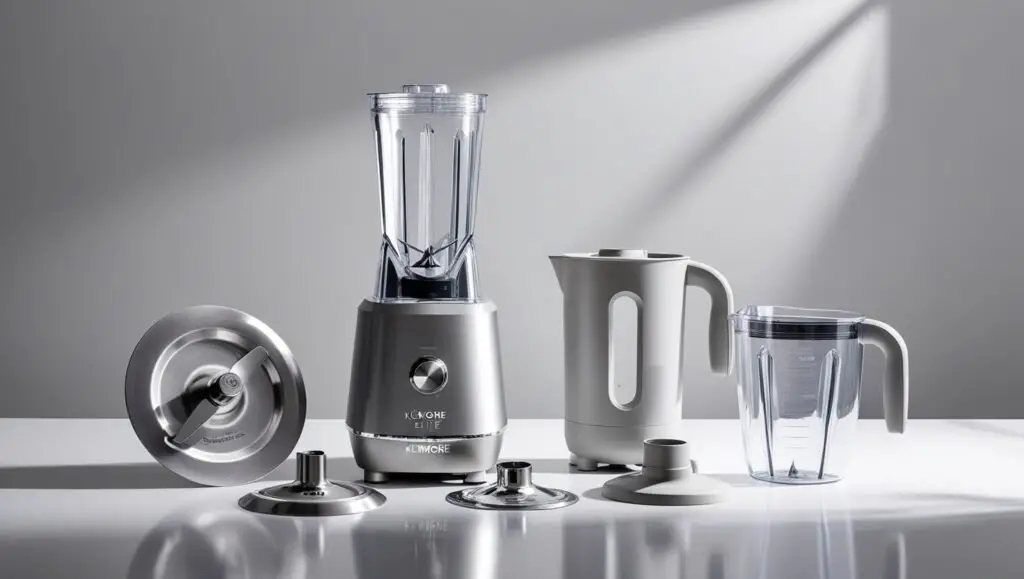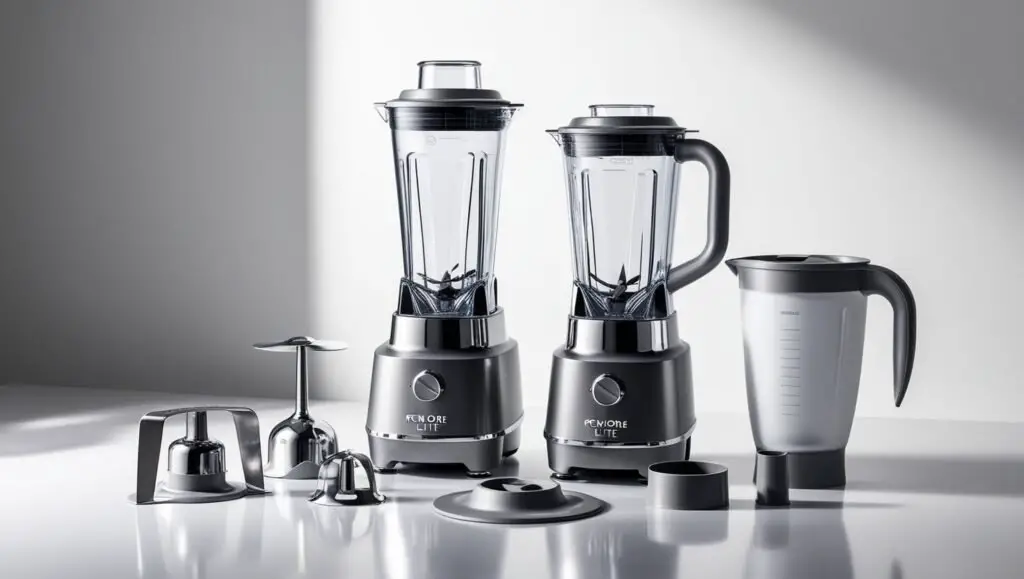As someone who loves whipping up smoothies and soups, I couldn’t live without my trusty Kenmore Elite Blender. However, I quickly discovered that understanding and maintaining its parts was just as important as mastering my favorite recipes. You won’t believe how many little bits and pieces are involved in making this amazing appliance work!
The Anatomy of Your Kenmore Elite Blender
Let’s take a closer look at the Kenmore Elite Blender. Understanding its parts can really improve your blending game. Each component plays an important role, and we need to recognize that.
1. Overview of Main Parts
- Motor: This is the powerhouse. Without a strong motor, your blender won’t mix well.
- Blade Assembly: Sharp blades create a smooth texture. They’re vital for perfect smoothies and soups.
- Jar: The jar holds your ingredients. It must be durable and easy to clean.
- Lid: A secure lid prevents spills and splatters. It’s essential for safety.
- Base: The base stabilizes the blender. It keeps everything steady while you blend.
2. Importance of Each Component
Every part of your blender contributes to its overall function. Think of it like a team if one member is not doing its job, the entire team struggles. The motor drives the blades, allowing them to chop and blend. Without a functioning motor, even the sharpest blades are useless!
The jar does more than just hold your ingredients. A strong jar can withstand high speeds without cracking. Important for those tough ingredients, right?
3. Damage and Performance
Now, let’s talk about wear. Did you know that the blade assembly is often a wear point? Dull blades can create lumps in your smoothies. The motor can also wear out over time. A struggling motor means slower blending, which can be frustrating.So, keeping an eye on these parts can save you headaches later.
4. Wear Areas to Watch Out For
Don’t forget to check the lid. If it’s not sealing properly, your blends can get messy. Also, pay attention to the base. If it’s wobbling, blending safely is at risk.
In short, understanding the anatomy of your Kenmore Elite Blender enhances your blending experience. Treat each part with care, and you’ll consistently achieve impressive results! Keep blending and enjoy those delicious creations!

Common Issues and How to Troubleshoot
We all love our blenders. But sometimes, they don’t perform as we expect. Let’s explore common issues and how to troubleshoot them effectively.
Identifying Problems with Blending Efficacy
Ever noticed your smoothie isn’t as smooth as it used to be? This might signal a blending issue. Here’s what to check:
- Blade condition: Are the blades dull or damaged? Dull blades struggle to blend.
- Ingredients: Are you adding too much at once? Overloading can cause problems.
- Liquid levels: Is there enough liquid to allow for proper blending? Right levels are key.
Unusual Noises: What to Check
If you’ve heard strange sounds, it’s essential to investigate. Here’s a quick checklist:
- Loose parts: Are any parts rattling? Tightening them can solve the problem.
- Overheating: Is your blender too hot? Allow it to cool down before next use.
- Electrical issues: Sticking noises might point to motor problems. Unplug it immediately.
Typical Wear and Tear Signals
Like anything mechanical, blenders show signs of wear and tear. How do you know when to replace parts? Here are some clues:
- Seal leaks: A gasket that’s worn out might lead to liquid leaks, impacting performance.
- Cracked jar: What’s that spiderweb pattern inside your jar? It may be time for a new one.
- Persistent issues: If problems occur frequently, a part replacement might be needed.
Sharing troubleshooting experiences can create a bond. Have you faced any of these issues? What steps did you take? Remember, consistent maintenance can prolong the life of your blender. By doing regular checks, you might avoid major headaches down the road.
In our next troubleshooting adventure, we can explore more in-depth ways to enhance blender usage across different recipes!
Where to Find Replacement Kenmore Elite Blender Parts
When it comes to finding replacement parts for your Kenmore Elite Blender, I know it can feel a bit overwhelming. Trust me, I’ve been there. Luckily, I’ve pulled together some insightful options to help you on the quest for those elusive parts.
1. Official Kenmore Parts Store
Your first stop should be the official Kenmore parts store. It’s the most reliable choice. They stock genuine parts specifically tailored for your blender. Think about it: it’s like going straight to the manufacturer for the best quality. Sure, it might cost a tad more, but you know you’re getting exactly what you need.
2. Third-Party Suppliers and Online Marketplaces
If you’re looking for savings, check out third-party suppliers and online marketplaces. Websites like eBay or Amazon often have a mix of OEM and generic products. Sometimes, I’ve found amazing deals. But beware; not all sellers are trustworthy. Always read reviews before purchasing. Is that seller reputable? Are the parts compatible with your model?
3. When to Opt for OEM Versus Generic Parts
The next question is: when should you choose OEM over generic parts? Here’s my take:
- OEM Parts: These are original parts made by Kenmore. Always prefer OEM parts unless cost is a major concern; quality is paramount,” a repair professional advises.
- Generic Parts: These might save you money, but they can lack the durability of genuine parts. They sometimes fit, but might not perform as well.
Pros and Cons of Different Suppliers
Each option has its pros and cons:
- Official Store: Highest quality, but pricier.
- Third-Party Suppliers: More affordable, but risks of lower quality.
- OEM vs Generic: Quality vs cost, which matters more for you?
Personal Experience
I once ordered a generic part online, hoping to save a few bucks. It worked sort of. A month in, I noticed it wasn’t quite as effective. Lesson learned. In such cases, opting for OEM makes a difference in the long run.
In summary, whether you’re leaning toward the official Kenmore parts store or scouring online marketplaces, consider your budget and the importance of quality. Your Kenmore Elite Blender deserves the best, after all!
Maximizing the Performance of Your Kenmore Elite Blender
Regular Cleaning Routines
Have you ever wondered why your blender sometimes smells funny or makes odd noises? I found out the hard way. One fateful morning, I blended a smoothie with leftover garlic from dinner. The result? A garlic-flavored breakfast smoothie. Yuck! This experience taught me the importance of regular cleaning routines to enhance longevity and maintain taste.
- Wash immediately after use. This prevents food from sticking and drying onto blades, which can cause wear and tear.
- Use warm, soapy water. A gentle scrub will do wonders – no need for extreme scrubbing.
- Don’t forget the base. Wipe the base with a damp cloth but never submerge it in water!
Best Practices for Ingredient Choices
Ingredients matter! Mixing fresh fruits with frozen ones can lead to blended perfection. However, the order of ingredients can change the game; don’t just toss everything in! advises a culinary instructor. By organizing your ingredients thoughtfully, you ensure a smoother blend.
Think in layers:
- Start with liquids at the bottom.
- Add softer ingredients next.
- Put frozen or hard ingredients towards the top.
Tips for Effective Usage
A little technique goes a long way! I used to just dump everything in. Well, let’s say my smoothies had an unusual consistency. Here are some tips to avoid my mishaps:
- Use the pulse feature for chunky ingredients. It’s great for creating salsas or dips.
- Don’t overfill the jar. Too much can lead to spills and a messy kitchen, trust me!
- Experiment with settings. Each function is there for a reason – find what works best for your needs.
User Habits Impacting Blender Wear
We all have habits, but are they good or bad for our trusty Kenmore Elite Blender? Bad habits, like leaving tough foods unblended or forgetting to clean, can contribute to increased wear of parts.
If we treat our appliances well, they can last for years. What’s the simplest way to ensure your blender stays in top shape? It starts with thoughtful use and care.

FAQ about Kenmore Elite Blender Parts
1. How Long Do Kenmore Elite Blender Parts Typically Last?
When it comes to Kenmore Elite Blender parts, longevity varies. Many users have reported that parts like blades and jars can last anywhere from 3 to 10 years. But why the difference? Usage plays a massive role. If you blend tough ingredients daily, your parts may wear out faster. Conversely, occasional use can extend their life.
2. What Is the Warranty on Replacement Parts?
The warranty period for replacement parts can be confusing. According to one customer service rep,
This means you can’t assume every part has the same coverage. Typically, parts may carry a warranty from 30 days to 1 year. It’s essential to read the fine print before buying replacements.
3. Can Different Model Parts Be Interchangeable?
This question often pops up in forums. Some Kenmore Elite Blender users wonder if they can mix and match parts from different models. In general, it’s risky to assume they’re interchangeable. While some parts may fit, others may not work effectively, compromising performance or safety. Always consult the user manual or check online forums for community experiences.
4. Community Tips
- Check online forums for real user experiences. They often have great advice!
- Keep your blender clean. Proper maintenance can extend part life.
- Track the usage of your blender. This can help you anticipate when parts may need replacement.
By addressing these common questions, I hope to ease some of your concerns about your Kenmore Elite Blender parts. Remember, understanding your blender’s needs leads to better performance and longevity!
Conclusion and Final Thoughts
As we wrap up our exploration of blender parts, it’s essential to recap their importance. Knowing your blender inside and out can really help in making informed decisions when it comes to repairs or replacements. Whether it’s a worn-out blade or a damaged jar, being aware of specific parts can save you time and money. After all, your blender is an essential tool in the kitchen, and taking care of it can prolong its life.
I’d love to hear from you! Have you ever faced an issue with your blender? Perhaps you’ve managed a successful repair or replaced a part yourself? Sharing your experiences creates a valuable community where we can learn from one another. Your stories could help someone else facing similar challenges.
Speaking of keeping blenders in great condition, I remember a time when my trusty Kenmore Elite Blender started making strange noises. Instead of panicking, I took the time to inspect the issue. I discovered that a simple tightening of its components resolved the problem. It reminded me that little maintenance can go a long way. These machines are worth caring for!
Let’s not forget how much we could benefit from actively participating in this community. We can share tips, tricks, and insights that make our blender usage better and more efficient. We can motivate each other to keep our blenders in top-notch shape. A little care can transform these everyday gadgets into long-lasting kitchen companions.
In conclusion, understanding blender parts is more than just about repairs; it’s about valuing the tool that assists us in our culinary adventures. Let’s continue to support one another in our blender journeys, ensuring that we squeeze out every last drop of usefulness from our beloved kitchen machines.
TL;DR: Kenmore Elite Blenders require specific parts for optimal performance. This guide covers essential components, maintenance tips, and frequently asked questions about replacement parts.
